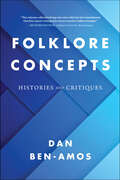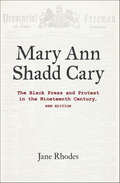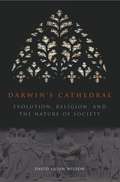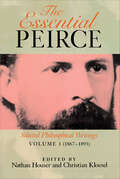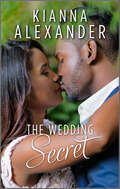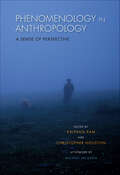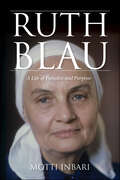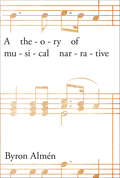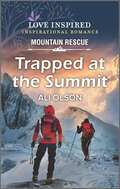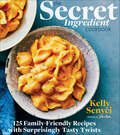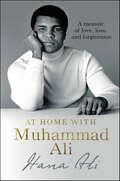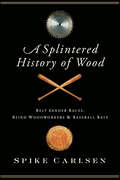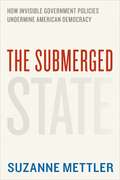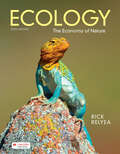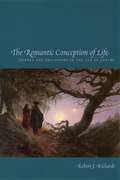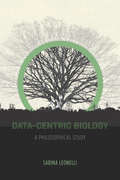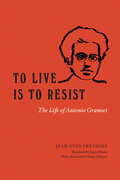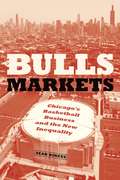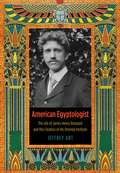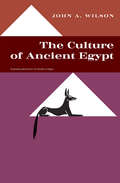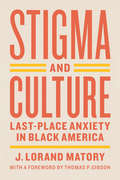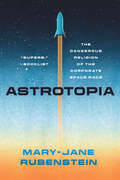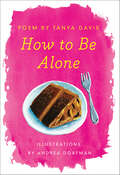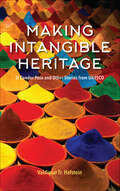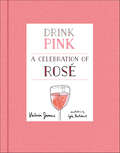- Table View
- List View
Folklore Concepts: Histories and Critiques
by Dan Ben-AmosBy defining folklore as artistic communication in small groups, Dan Ben-Amos led the discipline of Folklore in new directions. In Folklore Concepts, Henry Glassie and Elliott Oring have curated a selection of Ben-Amos's groundbreaking essays that explore folklore as a category in cultural communication and as a subject of scholarly research. Ben-Amos's work is well-known for sparking lively debate that often centers on why his definition intrinsically acknowledges tradition rather than expresses its connection forthright. Without tradition among people, there would be no art or communication, and tradition cannot accomplish anything on its own—only people can. Ben-Amos's focus on creative communication in communities is woven into the themes of the theoretical essays in this volume, through which he advocates for a better future for folklore scholarship. Folklore Concepts traces Ben-Amos's consistent efforts over the span of his career to review and critique the definitions, concepts, and practices of Folklore in order to build the field's intellectual history. In examining this history, Folklore Concepts answers foundational questions about what folklorists are doing, how they are doing it, and why.
Mary Ann Shadd Cary: The Black Press and Protest in the Nineteenth Century
by Jane RhodesMary Ann Shadd Cary was a courageous and outspoken nineteenth-century African American who used the press and public speaking to fight slavery and oppression in the United States and Canada. Part of the small free black elite who used their education and limited freedoms to fight for the end of slavery and racial oppression, Shadd Cary is best known as the first African American woman to publish and edit a newspaper in North America. But her importance does not stop there. She was an active participant in many of the social and political movements that influenced nineteenth century abolition, black emigration and nationalism, women's rights, and temperance. Mary Ann Shadd Cary: The Black Press and Protest in the Nineteenth Century explores her remarkable life and offers a window on the free black experience, emergent black nationalisms, African American gender ideologies, and the formation of a black public sphere. This new edition contains a new epilogue and new photographs.
Darwin's Cathedral: Evolution, Religion, and the Nature of Society
by David Sloan WilsonA study examining the connection between religious faith and human evolution.“Thoughtful and provocative. . . . Wilson turns to religion, which, he claims, can be explained only by group selection. According to Wilson, a religion is the human equivalent of a pack of lions: by cooperating as a group, people attain benefits beyond their reach as individuals.”―Times Literary Supplement, Book of the YearOne of the great intellectual battles of modern times is between evolution and religion. Until now, they have been considered completely irreconcilable theories of origin and existence. David Sloan Wilson's Darwin's Cathedral takes the radical step of joining the two, in the process proposing an evolutionary theory of religion that shakes both evolutionary biology and social theory at their foundations.The key, argues Wilson, is to think of society as an organism, an old idea that has received new life based on recent developments in evolutionary biology. If society is an organism, can we then think of morality and religion as biologically and culturally evolved adaptations that enable human groups to function as single units rather than mere collections of individuals? Wilson brings a variety of evidence to bear on this question, from both the biological and social sciences. From Calvinism in sixteenth-century Geneva to Balinese water temples, from hunter-gatherer societies to urban America, Wilson demonstrates how religions have enabled people to achieve by collective action what they never could do alone. He also includes a chapter considering forgiveness from an evolutionary perspective and concludes by discussing how all social organizations, including science, could benefit by incorporating elements of religion.Religious believers often compare their communities to single organisms and even to insect colonies. Astoundingly, Wilson shows that they might be literally correct. Intended for any educated reader, Darwin's Cathedral will change forever the way we view the relations among evolution, religion, and human society.“As always, Wilson writes well and clearly and in a stimulating and provocative style. The book is interesting and important, and there can be no higher praise. . . . I applaud the approach taken by Wilson, and I urge you to read Darwin’s Cathedral.” — Science“Wilson's book is more than just an attempt to understand religion. Even to readers with no interest in either religion or science, his book can serve as a model of how to discuss controversial subjects honestly.” —New York Review of Books
The Essential Peirce, Volume 1: Selected Philosophical Writings (The Essential Peirce)
by Nathan Houser and Christian KloeselThe first of two volumes of key texts from American philosopher Charles Sanders Peirce, the father of pragmatism.“Often considered the greatest American philosopher, Peirce produced no comprehensive treatise; until now, students and scholars had to read through widely scattered papers to gain an overall view of his thought. This anthology remedies that situation by offering a full representation of his work, including several hard-to-obtain items. . . . Highly recommended for scholarly collections.” —Library JournalA convenient two-volume reader's edition makes accessible to students and scholars the most important philosophical papers of the brilliant American thinker Charles Sanders Peirce. Volume 1 presents twenty-five key texts, chronologically arranged, beginning with Peirce’s “On a New List of Categories” of 1867, a highly regarded alternative to Kantian philosophy, and ending with the first sustained and systematic presentation of his evolutionary metaphysics in the Monist Metaphysical Series of 1891–1893. The book features a clear introduction and informative headnotes to help readers grasp the nature and significance of Peirce’s thought system. Bringing together all the writings needed for the study of Peirce’s systematic philosophy and its development, Volume 1 is ideal for classroom use. Volume 2, covering the period from 1894 until Peirce’s death in 1914, will highlight the development of his system of signs and his mature pragmatism.“A first-rate edition, which supersedes all other portable Peirces. . . . All the Peirce most people will ever need.” —Louis Menand, The New York Review of Books“The Monist essays are included in the first volume of the compact and welcome Essential Peirce; they are by Peirce's standards quite accessible and splendid in their cosmic scope and assertiveness.” ―London Review of Books
The Wedding Secret
by Kianna AlexanderA chance encounter with a handsome groomsman turns into so much more for a newly single wedding florist in this romantic reader-favorite story from Kianna Alexander!After discovering her fiancé’s public and utterly embarrassing infidelity, florist Renata McPherson is left dateless to her beloved client’s nuptials. But meaningful eye contact with one devastatingly handsome groomsman leaves Renata unexpectedly breathless…As a contractor, Amir Robertson has quite the knack for design. Though he has no plans for rebuilding the gorgeous shop owner’s heart…at first. Their no-strings-attached arrangement could soon fail when a secret that joins them forever is revealed.Previously published.
Phenomenology in Anthropology: A Sense of Perspective
by Michael JacksonThis volume explores what phenomenology adds to the enterprise of anthropology, drawing on and contributing to a burgeoning field of social science research inspired by the phenomenological tradition in philosophy. Essays by leading scholars ground their discussions of theory and method in richly detailed ethnographic case studies. The contributors broaden the application of phenomenology in anthropology beyond the areas in which it has been most influential—studies of sensory perception, emotion, bodiliness, and intersubjectivity—into new areas of inquiry such as martial arts, sports, dance, music, and political discourse.
Ruth Blau: A Life of Paradox and Purpose (Perspectives on Israel Studies)
by Motti InbariRuth Blau: A Life of Paradox and Purpose explores the life of a curious, if not mysterious, character in modern Jewish history. Born a French Catholic, Ruth Blau (Ben-David) (1920–2000) lived a constantly twisting life. During World War II, Blau was active in the French Resistance, and under their command, she joined the Gestapo as a double agent. After the war, she studied philosophy as a PhD candidate at the Sorbonne during the 1950s. After converting to Judaism and moving to Israel in 1960, Blau was involved in concealing Yossele Schumacher, a seven-year-old child, as part of a militant conflict between ultra-Orthodox and secular Jews in Israel. In 1965, despite a huge scandal, she married Amram Blau, head of the anti-Zionist ultra-Orthodox Neturei Karta. After the death of her husband in 1973, Blau took upon herself to travel to Arab countries to help the Jewish communities in distress in Lebanon and Iran, where she met Yasser Arafat, head of the Palestinian Liberation Organization, and his deputy Abu Jihad. But the most significant connections she made were in Iran. In 1979, she met with the leader of the Iranian revolution, Ayatollah Khomeini.Ruth Blau: A Life of Paradox and Purpose represents the first full-length biography of this remarkable woman. Drawing on a trove of archival materials and interviews with those who knew Ruth, Motti Inbari offers a complex, multifaceted portrait of a woman undertaking a remarkable and influential journey through modern European and Middle Eastern history.
A Theory of Musical Narrative (Musical Meaning and Interpretation)
by Byron AlménByron Almén proposes an original synthesis of approaches to musical narrative from literary criticism, semiotics, historiography, musicology, and music theory, resulting in a significant critical reorientation of the field. This volume includes an extensive survey of traditional approaches to musical narrative illustrated by a wide variety of musical examples that highlight the range and applicability of the theoretical apparatus. Almén provides a careful delineation of the essential elements and preconditions of musical narrative organization, an eclectic analytical model applicable to a wide range of musical styles and repertoires, a classification scheme of narrative types and subtypes reflecting conceptually distinct narrative strategies, a wide array of interpretive categories, and a sensitivity to the dependence of narrative interpretation on the cultural milieu of the work, its various audiences, and the analyst. A Theory of Musical Narrative provides both an excellent introduction to an increasingly important conceptual domain and a complex reassessment of its possibilities and characteristics.
Trapped at the Summit (Mountain Rescue)
by Ali OlsonThey will need each other to survive…But they&’re running out of time Valerie Butler won&’t let anything stop her from climbing Washington's formidable Mount Rainier. But when she partners with expert mountaineer Jonah Aarons, they confront unexpectedly brutal weather conditions—and one treacherous obstacle after another. Now, with Valerie&’s secrets and Jonah&’s tragic past overshadowing their every move, can they find the strength to survive—and make their way home to each other at last?
The Secret Ingredient Cookbook: 125 Family-Friendly Recipes with Surprisingly Tasty Twists
by Kelly Senyei“Unorthodox cooking hacks . . . This enjoyable shake-up of kitchen standards is full of what are bound to become new mealtime favorites.” —Publishers Weekly (starred review)Kelly Senyei, founder of the food site Just a Taste, has garnered millions of fans with a delicious hook—every one of her recipes has a secret ingredient, something totally unexpected that takes a dish from common to extraordinary. Some of the 125 tried-and-tested recipes are surprisingly simple, like her Vanilla Bean Drop Doughnuts made with Greek yogurt, or the Sweet and Tangy Baked Chicken Wings made with blackberry jam. Other recipes are nothing short of genius, such as the Kale Panzanella made with croissants, the Healthy White Chicken Chili made with hummus, or the Crispy Slow Cooker Carnitas made with cocoa powder. And just because the secret ingredients are surprising doesn’t mean they’re expensive or hard to find, either. Kelly is a busy mother of two, and she made sure every ingredient can be found in any supermarket. Her family-friendly recipes cover every occasion, from crowd-pleasing snacks and 30-minute entrées to make-ahead sides and holiday-worthy desserts.“Kelly Senyei has hit the nail on the head: Her book is full of delicious recipes that are both upgraded and familiar. The secret ingredients Kelly incorporates in her everyday recipes—like ginger ale in homemade waffles—are simple but wonderfully surprising. I love this book!” —Justin Chapple, culinary director-at-large, Food & Wine“Brilliant! Kelly Senyei’s ‘secret ingredient’ additions are so clever and easy, they will leave you smiling and wondering, ‘Why didn’t I think of that?’” —Elise Bauer, founder, Simply Recipes
At Home with Muhammad Ali: A Memoir of Love, Loss, and Forgiveness
by Hana AliMuhammad Ali’s daughter captures the legendary heavyweight boxing champion, Olympic Gold medalist, activist, and philanthropist as never before in this candid and intimate family memoir, based on personal recordings he kept throughout his adult life.Athlete. Activist. Champion. Ambassador. Icon. Father. The greatest, Muhammad Ali, is all of these things. In this candid family memoir, Hana Ali illuminates this momentous figure as only a daughter can. As Ali approached the end of his astonishing boxing career, he embraced a new purpose and role, turning his focus to his family and friends. In that role, he took center stage as an ambassador for peace and friendship. Dedicated to preserving his family’s unique history, Ali began recording a series of audio diaries in the 1970s, which his daughter later inherited. Through these private tapes, as well as personal journals, love letters, cherished memories, and many never-before-seen photographs, she reveals a complex man devoted to keeping all nine of his children united, and to helping others. Hana gives us a privileged glimpse inside the Ali home, sharing the everyday adventures her family experienced—all so “normal,” with visitors such as Clint Eastwood and John Travolta dropping by. She shares the joy and laughter, the hardship and pain, and, most importantly, the dedication and love that has bonded them. “It’s been said that my father is one of the most written-about people in the world,” Hana writes. “As the chronicles continue to grow, the deepest and most essential essence of his spirit is still largely unknown.” A moving and poignant love letter from a daughter to a father, At Home with Muhammad Ali is the untold story of Ali’s family legacy—a gift both eternal and priceless.
A Splintered History of Wood: Belt-Sander Races, Blind Woodworkers & Baseball Bats
by Spike CarlsenIn a world without wood, we might not be here at all. Without wood, we wouldn't have had the fire, heat, and shelter that allowed us to expand into the colder regions of the planet. If civilization somehow did develop, our daily lives still would be vastly different: there would be no violins, baseball bats, chopsticks, or wine corks. The book you are now holding wouldn't exist. At the same time, many of us are removed from the world where wood is shaped and celebrated every day. That world is inhabited by a unique assortment of eccentric craftsmen and passionate enthusiasts who have created some of the world's most beloved musical instruments, feared weapons, dazzling architecture, sacred relics, and bizarre forms of transportation. In A Splintered History of Wood, Spike Carlsen has uncovered the most outlandish characters and examples, from world-champion chainsaw carvers to blind woodworkers, the Miraculous Staircase to the Lindbergh kidnapping case, and many more, in a passionate and personal exploration of nature's greatest gift.
The Submerged State: How Invisible Government Policies Undermine American Democracy (Chicago Studies In American Politics Ser.)
by Suzanne Mettler“Keep your government hands off my Medicare!” Such comments spotlight a central question animating Suzanne Mettler’s provocative and timely book: why are many Americans unaware of government social benefits and so hostile to them in principle, even though they receive them? The Obama administration has been roundly criticized for its inability to convey how much it has accomplished for ordinary citizens. Mettler argues that this difficulty is not merely a failure of communication; rather it is endemic to the formidable presence of the “submerged state.” In recent decades, federal policymakers have increasingly shunned the outright disbursing of benefits to individuals and families and favored instead less visible and more indirect incentives and subsidies, from tax breaks to payments for services to private companies. These submerged policies, Mettler shows, obscure the role of government and exaggerate that of the market. As a result, citizens are unaware not only of the benefits they receive, but of the massive advantages given to powerful interests, such as insurance companies and the financial industry. Neither do they realize that the policies of the submerged state shower their largest benefits on the most affluent Americans, exacerbating inequality. Mettler analyzes three Obama reforms—student aid, tax relief, and health care—to reveal the submerged state and its consequences, demonstrating how structurally difficult it is to enact policy reforms and even to obtain public recognition for achieving them. She concludes with recommendations for reform to help make hidden policies more visible and governance more comprehensible to all Americans. The sad truth is that many American citizens do not know how major social programs work—or even whether they benefit from them. Suzanne Mettler’s important new book will bring government policies back to the surface and encourage citizens to reclaim their voice in the political process.
Ecology: The Economy of Nature
by Rick RelyeaEcology: The Economy of Nature takes students through all of the key concepts of an ecology course. It challenges them along the way with questions that encourage critical thinking, whether about chapter concepts, quantitative tools, or figures.
The Romantic Conception of Life: Science and Philosophy in the Age of Goethe
by Robert J. Richards"All art should become science and all science art; poetry and philosophy should be made one." Friedrich Schlegel's words perfectly capture the project of the German Romantics, who believed that the aesthetic approaches of art and literature could reveal patterns and meaning in nature that couldn't be uncovered through rationalistic philosophy and science alone. In this wide-ranging work, Robert J. Richards shows how the Romantic conception of the world influenced (and was influenced by) both the lives of the people who held it and the development of nineteenth-century science. Integrating Romantic literature, science, and philosophy with an intimate knowledge of the individuals involved—from Goethe and the brothers Schlegel to Humboldt and Friedrich and Caroline Schelling—Richards demonstrates how their tempestuous lives shaped their ideas as profoundly as their intellectual and cultural heritage. He focuses especially on how Romantic concepts of the self, as well as aesthetic and moral considerations—all tempered by personal relationships—altered scientific representations of nature. Although historians have long considered Romanticism at best a minor tributary to scientific thought, Richards moves it to the center of the main currents of nineteenth-century biology, culminating in the conception of nature that underlies Darwin's evolutionary theory. Uniting the personal and poetic aspects of philosophy and science in a way that the German Romantics themselves would have honored, The Romantic Conception of Life alters how we look at Romanticism and nineteenth-century biology.
Data-Centric Biology: A Philosophical Study
by Sabina LeonelliIn recent decades, there has been a major shift in the way researchers process and understand scientific data. Digital access to data has revolutionized ways of doing science in the biological and biomedical fields, leading to a data-intensive approach to research that uses innovative methods to produce, store, distribute, and interpret huge amounts of data. In Data-Centric Biology, Sabina Leonelli probes the implications of these advancements and confronts the questions they pose. Are we witnessing the rise of an entirely new scientific epistemology? If so, how does that alter the way we study and understand life—including ourselves? Leonelli is the first scholar to use a study of contemporary data-intensive science to provide a philosophical analysis of the epistemology of data. In analyzing the rise, internal dynamics, and potential impact of data-centric biology, she draws on scholarship across diverse fields of science and the humanities—as well as her own original empirical material—to pinpoint the conditions under which digitally available data can further our understanding of life. Bridging the divide between historians, sociologists, and philosophers of science, Data-Centric Biology offers a nuanced account of an issue that is of fundamental importance to our understanding of contemporary scientific practices.
To Live Is to Resist: The Life of Antonio Gramsci
by Jean-Yves FrétignéThis in-depth biography of Italian intellectual Antonio Gramsci casts new light on his life and writing, emphasizing his unflagging spirit, even in the many years he spent in prison. One of the most influential political thinkers of the twentieth century, Antonio Gramsci (1891–1937) has left an indelible mark on philosophy and critical theory. His innovative work on history, society, power, and the state has influenced several generations of readers and political activists, and even shaped important developments in postcolonial thought. But Gramsci’s thinking is scattered across the thousands of notebook pages he wrote while he was imprisoned by Italy’s fascist government from 1926 until shortly before his death. To guide readers through Gramsci’s life and works, historian Jean-Yves Frétigné offers To Live Is to Resist, an accessible, compelling, and deeply researched portrait of an extraordinary figure. Throughout the book, Frétigné emphasizes Gramsci’s quiet heroism and his unwavering commitment to political practice and resistance. Most powerfully, he shows how Gramsci never surrendered, even in conditions that stripped him of all power—except, of course, the power to think.
Bulls Markets: Chicago's Basketball Business and the New Inequality (Historical Studies of Urban America)
by Sean DincesAn unvarnished look at the economic and political choices that reshaped contemporary Chicago—arguably for the worse. ? The 1990s were a glorious time for the Chicago Bulls, an age of historic championships and all-time basketball greats like Scottie Pippen and Michael Jordan. It seemed only fitting that city, county, and state officials would assist the team owners in constructing a sparkling new venue to house this incredible team that was identified worldwide with Chicago. That arena, the United Center, is the focus of Bulls Markets, an unvarnished look at the economic and political choices that forever reshaped one of America’s largest cities—arguably for the worse. Sean Dinces shows how the construction of the United Center reveals the fundamental problems with neoliberal urban development. The pitch for building the arena was fueled by promises of private funding and equitable revitalization in a long-blighted neighborhood. However, the effort was funded in large part by municipal tax breaks that few ordinary Chicagoans knew about, and that wound up exacerbating the rising problems of gentrification and wealth stratification. In this portrait of the construction of the United Center and the urban life that developed around it, Dinces starkly depicts a pattern of inequity that has become emblematic of contemporary American cities: governments and sports franchises collude to provide amenities for the wealthy at the expense of poorer citizens, diminishing their experiences as fans and—far worse—creating an urban environment that is regulated and surveilled for the comfort and protection of that same moneyed elite.
American Egyptologist: The Life of James Henry Breasted and the Creation of His Oriental Institute
by Jeffrey AbtJames Henry Breasted (1865–1935) had a career that epitomizes our popular image of the archaeologist. Daring, handsome, and charismatic, he traveled on expeditions to remote and politically unstable corners of the Middle East, helped identify the tomb of King Tut, and was on the cover of Time magazine. But Breasted was more than an Indiana Jones—he was an accomplished scholar, academic entrepreneur, and talented author who brought ancient history to life not just for students but for such notables as Teddy Roosevelt and Sigmund Freud.In American Egyptologist, Jeffrey Abt weaves together the disparate strands of Breasted’s life, from his small-town origins following the Civil War to his evolution into the father of American Egyptology and the founder of the Oriental Institute in the early years of the University of Chicago. Abt explores the scholarly, philanthropic, diplomatic, and religious contexts of his ideas and projects, providing insight into the origins of America’s most prominent center for Near Eastern archaeology. An illuminating portrait of the nearly forgotten man who demystified ancient Egypt for the general public, American Egyptologist restores James Henry Breasted to the world and puts forward a brilliant case for his place as one of the most important scholars of modern times.
The Culture of Ancient Egypt: Originally published as The Burden of Egypt
by John A. WilsonThe story of Egypt is the story of history itself—the endless rise and fall, the life and death and life again of the eternal human effort to endure, enjoy, and understand the mystery of our universe. Emerging from the ancient mists of time, Egypt met the challenge of the mystery in a glorious evolution of religious, intellectual, and political institutions and for two millenniums flourished with all the vigor that the human heart can invest in a social and cultural order. Then Egypt began to crumble into the desert sands and the waters of the Nile, and her remarkable achievements in civilization became her lingering epitaph. John A. Wilson has written a rich and interpretive biography of one of the greatest cultural periods in human experience. He answers—as best the modern Egyptologist can—the questions inevitably asked concerning the dissolution of Egypt's glory. Here is scholarship in its finest form, concerned with the humanity that has preceded us, and finding in man's past grandeur and failure much meaning for men of today.
Stigma and Culture: Last-Place Anxiety in Black America (Lewis Henry Morgan Lecture Ser.)
by J. Lorand MatoryIn Stigma and Culture, J. Lorand Matory provocatively shows how ethnic identification in the United States—and around the globe—is a competitive and hierarchical process in which populations, especially of historically stigmatized races, seek status and income by dishonoring other stigmatized populations. And there is no better place to see this than among the African American elite in academia, where he explores the emergent ethnic identities of African and Caribbean immigrants and transmigrants, Gullah/Geechees, Louisiana Creoles, and even Native Americans of partly African ancestry. Matory describes the competitive process that hierarchically structures their self-definition as ethnic groups and the similar process by which middle-class African Americans seek distinction from their impoverished compatriots. Drawing on research at universities such as Howard, Harvard, and Duke and among their alumni networks, he details how university life—while facilitating individual upward mobility, touting human equality, and regaling cultural diversity—also perpetuates the cultural standards that historically justified the dominance of some groups over others. Combining his ethnographic findings with classic theoretical insights from Frantz Fanon, Fredrik Barth, Erving Goffman, Pierre Bourdieu and others—alongside stories from his own life in academia—Matory sketches the university as an institution that, particularly through the anthropological vocabulary of culture, encourages the stigmatized to stratify their own.
Astrotopia: The Dangerous Religion of the Corporate Space Race
by Mary-Jane RubensteinA revealing look at the parallel mythologies behind the colonization of Earth and space—and a bold vision for a more equitable, responsible future both on and beyond our planet. As environmental, political, and public health crises multiply on Earth, we are also at the dawn of a new space race in which governments team up with celebrity billionaires to exploit the cosmos for human gain. The best-known of these pioneers are selling different visions of the future: while Elon Musk and SpaceX seek to establish a human presence on Mars, Jeff Bezos and Blue Origin work toward moving millions of earthlings into rotating near-Earth habitats. Despite these distinctions, these two billionaires share a core utopian project: the salvation of humanity through the exploitation of space. In Astrotopia, philosopher of science and religion Mary-Jane Rubenstein pulls back the curtain on the not-so-new myths these space barons are peddling, like growth without limit, energy without guilt, and salvation in a brand-new world. As Rubenstein reveals, we have already seen the destructive effects of this frontier zealotry in the centuries-long history of European colonialism. Much like the imperial project on Earth, this renewed effort to conquer space is presented as a religious calling: in the face of a coming apocalypse, some very wealthy messiahs are offering an other-worldly escape to a chosen few. But Rubenstein does more than expose the values of capitalist technoscience as the product of bad mythologies. She offers a vision of exploring space without reproducing the atrocities of earthly colonialism, encouraging us to find and even make stories that put cosmic caretaking over profiteering.
How to Be Alone
by Tanya DavisSince its debut on YouTube, Tanya Davis’s beautiful and perceptive poem "How to Be Alone," visually realized by artist and filmmaker Andrea Dorfman, has become an international sensation. In this edition of How to Be Alone, they have adapted the poem and its compelling illustrations for the page in a beautiful, meditative volume—a keepsake to treasure and to share. From a solitary walk in the woods to sitting unaccompanied on a city park bench to eating a meal and even dancing alone, How to Be Alone, reveals the possibilities and joys waiting to be discovered when we engage in activities on our own. As she soothes the disquietude that accompanies the fear of aloneness, and celebrates the power of solitude to change how we see ourselves and the world, Tanya reveals how, removed from the noise and distractions of other lives, we can find acceptance and grace within.For those who have never been by themselves or those who embrace being on their own, How to Be Alone encourages us to recognize and embrace the possibilities of being alone—and reminds us of a universe of joy, peace, and discovery waiting to unfold.
Making Intangible Heritage: El Condor Pasa and Other Stories from UNESCO
by Valdimar Tr. HafsteinIn Making Intangible Heritage, Valdimar Tr. Hafstein—folklorist and official delegate to UNESCO—tells the story of UNESCO's Intangible Heritage Convention. In the ethnographic tradition, Hafstein peers underneath the official account, revealing the context important for understanding UNESCO as an organization, the concept of intangible heritage, and the global impact of both. Looking beyond official narratives of compromise and solidarity, this book invites readers to witness the diplomatic jostling behind the curtains, the making and breaking of alliances, and the confrontation and resistance, all of which marked the path towards agreement and shaped the convention and the concept.Various stories circulate within UNESCO about the origins of intangible heritage. Bringing the sensibilities of a folklorist to these narratives, Hafstein explores how they help imagine coherence, conjure up contrast, and provide charters for action in the United Nations and on the ground. Examining the international organization of UNESCO through an ethnographic lens, Hafstein demonstrates how concepts that are central to the discipline of folklore gain force and traction outside of the academic field and go to work in the world, ultimately shaping people's understanding of their own practices and the practices themselves. From the cultural space of the Jemaa el-Fna marketplace in Marrakech to the Ise Shrine in Japan, Making Intangible Heritage considers both the positive and the troubling outcomes of safeguarding intangible heritage, the lists it brings into being, the festivals it animates, the communities it summons into existence, and the way it orchestrates difference in modern societies.
Drink Pink: A Celebration of Rosé
by Victoria JamesCombining delightful stories with whimsical and clever illustrations, Drink Pink is a clever, captivating, and unpretentious look at rosé for novices and connoisseurs alike. For years, rosé has lived a quiet life as the not-red and not-white wine, but in the last five years this vintage has taken its rightful place in the spotlight. Use this book as a guide to rosé’s myriad of pleasures. Comprehensive and complete with both esoteric knowledge and entirely practical cocktails and dinner party recipes, this is the perfect book give your girlfriend or keep to display for yourself!Part 1: Rosé Is Old School – Learn about the three-thousand-year history of rosé, and see exactly why it took so long for this wine to saturate American culture.Part 2: Producing Pink Juice – Discover the crafting methods that set rosé apart from other wines, and get a crash course in the significance of saignée, skin contact, blending, and more!Part 3: People and Places – Study the different producers of rosé and start talking like a true sommelier.Part 4: Why and How to Drink Pink – hear professional foodies and wine experts sing praises about pink wine, and –Part 5: Recipes – Enjoy a myriad of rosé-related recipes. Here, the options are endless! Cocktail recipes starring rosé; appetizer, entrée, and side dishes that include or pair well with rosé; classy desserts and the best types of rosé to accent them. There’s no better way to get in the pink than with Drink Pink!
